The mobile FG nucleoporin Nup98 is a cofactor for Crm1-dependent protein export
- PMID: 20375145
- PMCID: PMC2877646
- DOI: 10.1091/mbc.e09-12-1041
The mobile FG nucleoporin Nup98 is a cofactor for Crm1-dependent protein export
Abstract
Nup98 is a mobile nucleoporin that forms distinct dots in the nucleus, and, although a role for Nup98 in nuclear transport has been suggested, its precise function remains unclear. Here, we show that Nup98 plays an important role in Crm1-mediated nuclear protein export. Nuclear, but not cytoplasmic, dots of EGFP-tagged Nup98 disappeared rapidly after cell treatment with leptomycin B, a specific inhibitor of the nuclear export receptor, Crm1. Mutational analysis demonstrated that Nup98 physically and functionally interacts with Crm1 in a RanGTP-dependent manner through its N-terminal phenylalanine-glycine (FG) repeat region. Moreover, the activity of the Nup98-Crm1 complex was modulated by RanBP3, a known cofactor for Crm1-mediated nuclear export. Finally, cytoplasmic microinjection of anti-Nup98 inhibited the Crm1-dependent nuclear export of proteins, concomitant with the accumulation of anti-Nup98 in the nucleus. These results clearly demonstrate that Nup98 functions as a novel shuttling cofactor for Crm1-mediated nuclear export in conjunction with RanBP3.
Figures

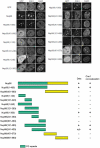
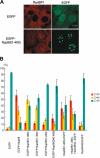

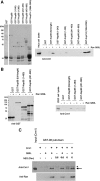
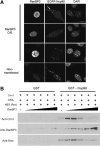
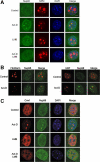


Similar articles
-
Inhibition of CRM1-mediated nuclear export of transcription factors by leukemogenic NUP98 fusion proteins.J Biol Chem. 2010 May 21;285(21):16248-57. doi: 10.1074/jbc.M109.048785. Epub 2010 Mar 16. J Biol Chem. 2010. PMID: 20233715 Free PMC article.
-
The nucleoporin-like protein NLP1 (hCG1) promotes CRM1-dependent nuclear protein export.J Cell Sci. 2012 Jan 1;125(Pt 1):144-54. doi: 10.1242/jcs.090316. Epub 2012 Jan 16. J Cell Sci. 2012. PMID: 22250199
-
Several phenylalanine-glycine motives in the nucleoporin Nup214 are essential for binding of the nuclear export receptor CRM1.J Biol Chem. 2013 Feb 8;288(6):3952-63. doi: 10.1074/jbc.M112.433243. Epub 2012 Dec 21. J Biol Chem. 2013. PMID: 23264634 Free PMC article.
-
Mechanistic Insights from Structural Analyses of Ran-GTPase-Driven Nuclear Export of Proteins and RNAs.J Mol Biol. 2016 May 22;428(10 Pt A):2025-39. doi: 10.1016/j.jmb.2015.09.025. Epub 2015 Oct 28. J Mol Biol. 2016. PMID: 26519791 Review.
-
Inhibition of CRM1-dependent nuclear export sensitizes malignant cells to cytotoxic and targeted agents.Semin Cancer Biol. 2014 Aug;27:62-73. doi: 10.1016/j.semcancer.2014.03.001. Epub 2014 Mar 12. Semin Cancer Biol. 2014. PMID: 24631834 Free PMC article. Review.
Cited by
-
Amino-terminal enhancer of split (AES) interacts with the oncoprotein NUP98-HOXA9 and enhances its transforming ability.J Biol Chem. 2011 Nov 11;286(45):38989-9001. doi: 10.1074/jbc.M111.297952. Epub 2011 Sep 21. J Biol Chem. 2011. PMID: 21937451 Free PMC article.
-
Chromatin-prebound Crm1 recruits Nup98-HoxA9 fusion to induce aberrant expression of Hox cluster genes.Elife. 2016 Jan 7;5:e09540. doi: 10.7554/eLife.09540. Elife. 2016. PMID: 26740045 Free PMC article.
-
Human regulator of telomere elongation helicase 1 (RTEL1) is required for the nuclear and cytoplasmic trafficking of pre-U2 RNA.Nucleic Acids Res. 2015 Feb 18;43(3):1834-47. doi: 10.1093/nar/gku1402. Epub 2015 Jan 27. Nucleic Acids Res. 2015. PMID: 25628358 Free PMC article.
-
The role of Nup98 in transcription regulation in healthy and diseased cells.Trends Cell Biol. 2013 Mar;23(3):112-7. doi: 10.1016/j.tcb.2012.10.013. Epub 2012 Dec 13. Trends Cell Biol. 2013. PMID: 23246429 Free PMC article.
-
The Oncogenic Fusion Proteins SET-Nup214 and Sequestosome-1 (SQSTM1)-Nup214 Form Dynamic Nuclear Bodies and Differentially Affect Nuclear Protein and Poly(A)+ RNA Export.J Biol Chem. 2016 Oct 28;291(44):23068-23083. doi: 10.1074/jbc.M116.735340. Epub 2016 Sep 9. J Biol Chem. 2016. PMID: 27613868 Free PMC article.
References
Publication types
MeSH terms
Substances
LinkOut - more resources
Full Text Sources
Other Literature Sources

